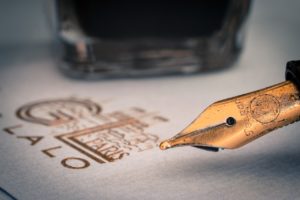
You don’t need a pistol to rob a bank. A pen will do nicely, too.
As the American Civil War drew to a close, a 19th-century forgery conspiracy proved that point quite nicely. Dressed as elegant businessmen, the crooks robbed banks with pen and paper. In time, this group became the most successful forgers in the world. Its crimes almost broke the Bank of England. The case pitted the best detective in the world – Willie Pinkerton – against the so-called “Terror of Wall Street,” and led law enforcement on a wild goose chase throughout the world.
The 19th-century forgery case that made history
British author and broadcaster Nicholas Booth recently published a book about the 19th-century’s most famous fraud case, The Thieves of Threadneedle Street: The Incredible True Story of the American Forgers Who Nearly Broke the Bank of England (New York: Pegasus Books, 2016). He tells the true story of the most spectacular forgery in history – how four Yankee rascals attempted daylight robbery from the Bank of England. Their crime has never been equaled in complexity nor scope ever since. In 1873, a boom in financial services – thanks to a rise in negotiable paper and international trade – led to a brisk market in what were known as bills of exchange. They were essentially credit notes that could be bought and sold by reputable bankers. “A bill on London” had the financial weight of the Old Lady of Threadneedle Street (the Bank of England) behind it. And, needless to say, clever criminals realized they could make a killing.

Author Nicholas Booth joins us for an interview.
How did one commit a 19th-century forgery?
Slowly and carefully – if they wanted to avoid jail! Forgers had to be a unique mixture of artists, chemists and criminals. The key to what they had to do was learning how to forge documents. That took practice and refinement. And when the gang in this story moved to London, they realized they could sub-divide all the tasks involved to innocent craftsmen– platemaking, letterings, ink and paper production, and the actual printing. All they had to do for themselves was learn how to forge signatures. For that, they teamed up with a master forger who styled himself as “The Terror of Wall Street”.
At some point, a particularly talented group of criminals started up a 19th-century forgery ring in North America. Tell us about them.
Two of them were brothers, Austin and George Bidwell. They were born in Michigan and it is hard to know who was the worse influence! They started out in long firm fraud in the 1860s – that is, obtaining goods on credit and then selling them off before the money was due. They did that all over the mid-west. They then roped in an Irish-Canadian called George Macdonnell who was a charming, slippery rogue and he knew someone called Edwin Noyes Hills, who they tended to use as the catspaw – the innocent dupe. They moved to New York in about 1867 and learned their trade over the next five years. They became ever more ambitious.
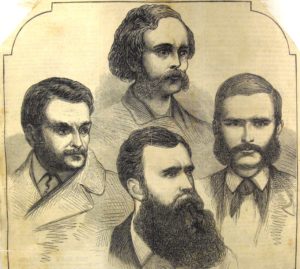
You say this group committed the first truly professional white-collar job – one that set the standards for future criminals. What did it do?
It showed that you didn’t have to use brute force to commit a 19th-century forgery. Thanks to the rise of government bonds, you didn’t have to use dynamite or violence. So long as you were clever, methodical and took things slowly, you could build up credit, bona fides and credibility. That’s what they started to do in New York – and then all over the U.S. In 1871, they planned a spectacular – where small checks would be changed to bigger ones all on the same day in different cities – but one of their helpers panicked. So they carried on in other parts of Europe, where they weren’t so well known – and the Old Lady of Threadneedle Street was an obvious target.
How did this gang move on from American forgeries to international ones?
They were put up to it by the New York Police Department. The cops regularly took a rake off after turning blind eyes to the removal of international bonds in Manhattan. The whole market wasn’t regulated. So two of them came to Europe in 1870 and because all Americans were presumed to be rich, they were believable. They used that for seed capital for a series of other jobs. Two years later, all four of them crossed the Atlantic together and spent the best part of 1872 probing and learning about the European monetary system to find any weaknesses. Incredibly, they didn’t attempt anything fraudulent for those nine or so months.
What countries did its members visit and defraud?
Great Britain, France, Austria, Germany, and Ireland. That was in 1870. They came back to London two years later and then, in the spring of 1873, they added Spain and Cuba to their list of destinations. They were literally chased all over the world.
How close did they come to breaking the Bank of England?
Very! The odd thing was that in the months when they presenting forged bills of exchange at the bank, they made silly mistakes which should have been picked up. But they weren’t. Even though the bank gave them just over £100,000 – about $5 million in today’s money! – its officials didn’t check on their bona fides, their credit or even their real identities. It was really a race against time – the ticking clock is basically the heart of the story.
How did the Bank of England catch the forgeries?
By accident. Three months into the fraud, they had sent in a bill of exchange that had a signature missing. When one of the clerks in Threadneedle Street came to investigate, he realized something wasn’t quite right. He checked all the files and, to his horror, saw that all these particular ones were forgeries. So there was a hue and cry and one of the forgers was caught red-handed in another bank that same day.
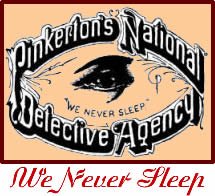
What role did the Pinkerton National Detective Agency play in catching the forgers?
A crucial one. Willie Pinkerton, who ran the Chicago office, knew all of them of old. He actually bumped into them on The Strand in London the winter before so knew that they were up to something. He’d heard a “spectacular” was being planned. So he warned the Bank of England but wasn’t listened to. When the forgeries were discovered, he had a pretty shrewd idea who was behind it all. And so the chase began!
Were all of them caught?
Yes, in the sense that the four main characters were. There were chases, escapes and double crosses. Yet when they were all run down, many in law enforcement felt that there might have been others involved; and I end the book with a death bed confession which adds credence to that. I’ll let the reader decide!
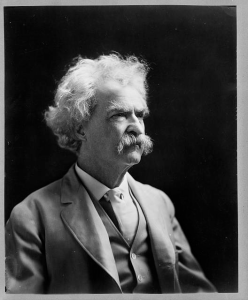
Mark Twain and Harriet Beecher Stowe petitioned for a more lenient sentence for one of the forgers. Why?
All four had the book thrown at them. They were given life sentences, but one by one, they were let out – apart from the youngest, Austin Bidwell. For some reason, the British authorities thought he was the mastermind even though he was only 27 years of age when he had been sent down. When they were sentenced, there was shock. Nobody lost their lives or livelihoods and, ultimately, the bank was insured. So the wise and famous got involved in petitions on Austin’s behalf – and even when he saved a drowning man in a prison, the authorities still wouldn’t let him out for another decade.
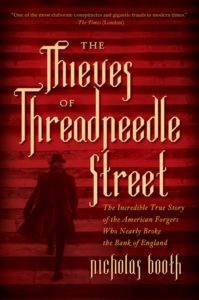
Thank you, Nicholas Booth!
Literature on point:
Nicholas Booth , The Thieves of Threadneedle Street: The Incredible True Story of the American Forgers Who Nearly Broke the Bank of England (New York: Pegasus Books, 2016).



